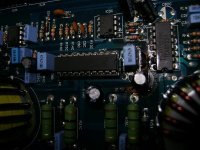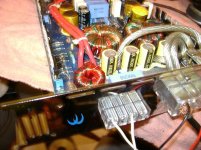I have a BXi 1606 that had a high pitched whine coming from the speakers. Replaced the HIP4080a and got rid of the whine, but there is about a 1.6v float on the output and there is a sound like an am receiver listening to sunspot activity if you listen closely to the speaker.
Some background on the unit: It was previously repaired and has FQP65n06's in power supply (is this original?). the ground ref trace that goes around the HIP4080a is lifted and burnt but not severed.
Here are some pics:
Any ideas?
Some background on the unit: It was previously repaired and has FQP65n06's in power supply (is this original?). the ground ref trace that goes around the HIP4080a is lifted and burnt but not severed.
Here are some pics:
Any ideas?
Attachments
The noise is likely because they don't synchronize the power supply frequency to the output carrier frequency. It's normal. People with amps, new out of the box have had the same complaints.
If you measure the DC voltage from the negative speaker terminal to the positive speaker terminal (after the relay engages) and have more than 0.025v DC offset, adjust VR10 until it's 0.025v or below. Do this with no audio input.
If you measure the DC voltage from the negative speaker terminal to the positive speaker terminal (after the relay engages) and have more than 0.025v DC offset, adjust VR10 until it's 0.025v or below. Do this with no audio input.
Thanks, I did adjust the Bias pot but could only get it to .9v, also seeing quick warmth from tip41 bias? chip.
Sound does seem more excessive than even John Studley would allow.
 Said with all respect.
Said with all respect.
Could it be the TC4013BP Flipflop, causing the frequency mismatch and bias voltage? It looks like it was warmed by the trace almost failure.
Sound does seem more excessive than even John Studley would allow.
Could it be the TC4013BP Flipflop, causing the frequency mismatch and bias voltage? It looks like it was warmed by the trace almost failure.
Tracked down 6.2V zener. Got 6.5v and still float.
Parts order came in and replaced 4080a with new intersil, dc float went away and I could zero.
I have a couple of more questions.
How much warming should I expect out of 4080a in early low power testing?
The AM Noise is really noticeable and I have not heard it this loud out of new amps before, 20yrs experience, former Hifonics rep.
Could it be something with one of the lm393N's, I can physically touch the case of one of them and sound changes character?
Sorry, No scope, it sold with the store.
I still had the noise with the last NJM4558L pulled out of circuit to isolate from preamp. (one of the legs broke and replaced with NJM4558LD, will this be OK?)
BTW Thanks again for the advice.
Parts order came in and replaced 4080a with new intersil, dc float went away and I could zero.
I have a couple of more questions.
How much warming should I expect out of 4080a in early low power testing?
The AM Noise is really noticeable and I have not heard it this loud out of new amps before, 20yrs experience, former Hifonics rep.
Could it be something with one of the lm393N's, I can physically touch the case of one of them and sound changes character?
Sorry, No scope, it sold with the store.
I still had the noise with the last NJM4558L pulled out of circuit to isolate from preamp. (one of the legs broke and replaced with NJM4558LD, will this be OK?)
BTW Thanks again for the advice.
The 4080 will get warm but shouldn't be too hot to hold your finger on.
Earlier, you stated that you had to have your ear near the speaker to hear it. If it's significantly louder, there may be another problem. Is it louder now?
What's the circuit board designation for the op-amp that you pulled?
If your amp has yellow filter capacitors near the B+ terminal, they sometimes fail. I've seen quite a few fail and they looked perfectly fine (no visible evidence of damage). If you parallel another relatively large capacitor across the B+ and ground terminals and the noise changes significantly, those caps may be defective. When the capacitance goes very low, the amp will generally refuse to start. I'm not sure what happens when they are simply below rated capacitance.
I can't find the datasheet on the LD version of the op-amp. I don't think there will be a significant difference.
Earlier, you stated that you had to have your ear near the speaker to hear it. If it's significantly louder, there may be another problem. Is it louder now?
What's the circuit board designation for the op-amp that you pulled?
If your amp has yellow filter capacitors near the B+ terminal, they sometimes fail. I've seen quite a few fail and they looked perfectly fine (no visible evidence of damage). If you parallel another relatively large capacitor across the B+ and ground terminals and the noise changes significantly, those caps may be defective. When the capacitance goes very low, the amp will generally refuse to start. I'm not sure what happens when they are simply below rated capacitance.
I can't find the datasheet on the LD version of the op-amp. I don't think there will be a significant difference.
""What's the circuit board designation for the op-amp that you pulled?
IC1a
""Earlier, you stated that you had to have your ear near the speaker to hear it. If it's significantly louder, there may be another problem. Is it louder now?
No not louder, just a matter of my ambient noise level changing in the room, and more time testing as I would not run it long with the float issue.
""If your amp has yellow filter capacitors near the B+ terminal, they sometimes fail. I've seen quite a few fail and they looked perfectly fine (no visible evidence of damage). If you parallel another relatively large capacitor across the B+ and ground terminals and the noise changes significantly, those caps may be defective. When the capacitance goes very low, the amp will generally refuse to start. I'm not sure what happens when they are simply below rated capacitance.
I was not going to share this part but I can't resist; Please look at the pictures, Other than their odd designation LOL I think they are fine. ( they are factory glued in and have not been tampered with.).
Other than their odd designation LOL I think they are fine. ( they are factory glued in and have not been tampered with.).
But in thinking about them I have a thought, " I have an inverted (PWM?) power supply (CAE 75 AMP long and silver) and no filter caps or battery in between. Could this be the issue? It has not done so with any of the other amps I have been putting on it.
IC1a
""Earlier, you stated that you had to have your ear near the speaker to hear it. If it's significantly louder, there may be another problem. Is it louder now?
No not louder, just a matter of my ambient noise level changing in the room, and more time testing as I would not run it long with the float issue.
""If your amp has yellow filter capacitors near the B+ terminal, they sometimes fail. I've seen quite a few fail and they looked perfectly fine (no visible evidence of damage). If you parallel another relatively large capacitor across the B+ and ground terminals and the noise changes significantly, those caps may be defective. When the capacitance goes very low, the amp will generally refuse to start. I'm not sure what happens when they are simply below rated capacitance.
I was not going to share this part but I can't resist; Please look at the pictures,
 Other than their odd designation LOL I think they are fine. ( they are factory glued in and have not been tampered with.).
Other than their odd designation LOL I think they are fine. ( they are factory glued in and have not been tampered with.).
But in thinking about them I have a thought, " I have an inverted (PWM?) power supply (CAE 75 AMP long and silver) and no filter caps or battery in between. Could this be the issue? It has not done so with any of the other amps I have been putting on it.
Attachments
Are you 100% sure that they are the original caps. Many times, the caps can be removed and the adhesive will remain on the board. If the new caps were the same size, it would appear that they were held by the adhesive. It would be surprising to see kicker caps in it because the hifonics and kicker amps use entirely different designs. Hifonics uses S3-tech boards and the 4080 ICs. Kicker uses the 4060 and Lm361 circuit. I wouldn't expect them to be produced by the same build house.
The caps that have been failing looked similar to the other yellow caps (samcon?).
If the power supply is a regulated 12v supply, it almost certainly has internal filter caps. Generally, the only 12v supplies without capacitors are battery chargers.
Is your signal source ground connected to the DC power supply ground?
The caps that have been failing looked similar to the other yellow caps (samcon?).
If the power supply is a regulated 12v supply, it almost certainly has internal filter caps. Generally, the only 12v supplies without capacitors are battery chargers.
Is your signal source ground connected to the DC power supply ground?
There are only a couple of trusted build houses for D Class, I used to know the main three.
If this amp was made during the Circuit City fall, Kicker had cut production rather quickly. lots of parts on open market in China.
The power rail caps are Samcon. I will check them.
Power supply is well filtered, but I was trying to think outside the box.
Gounding is all common.
After I test caps I am going to assemble and put amp through thorough testing.
If this amp was made during the Circuit City fall, Kicker had cut production rather quickly. lots of parts on open market in China.
The power rail caps are Samcon. I will check them.
Power supply is well filtered, but I was trying to think outside the box.
Gounding is all common.
After I test caps I am going to assemble and put amp through thorough testing.

- Status
- This old topic is closed. If you want to reopen this topic, contact a moderator using the "Report Post" button.
- Home
- General Interest
- Car Audio
- HIfonics BXi 1606 voltage float sound issue

